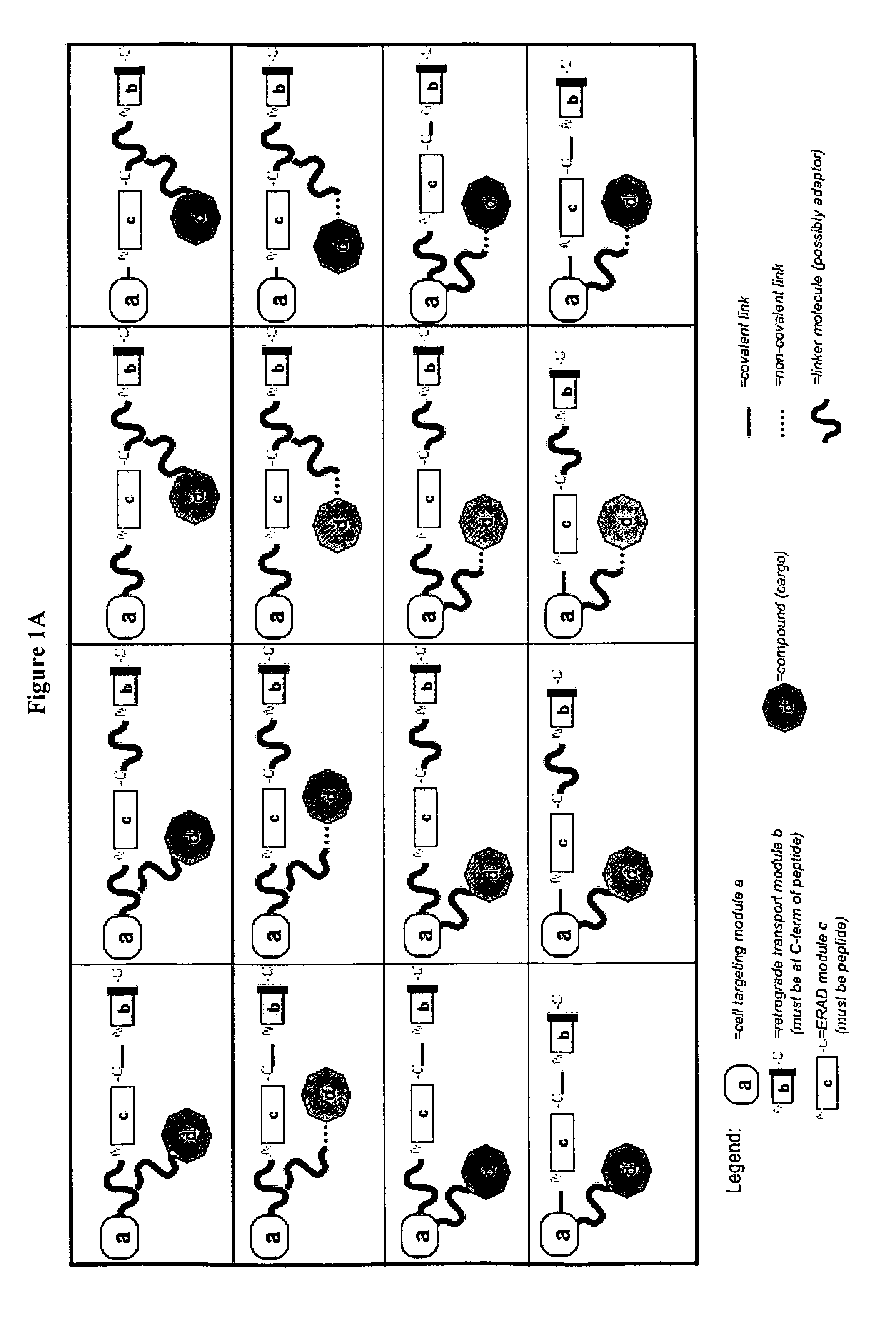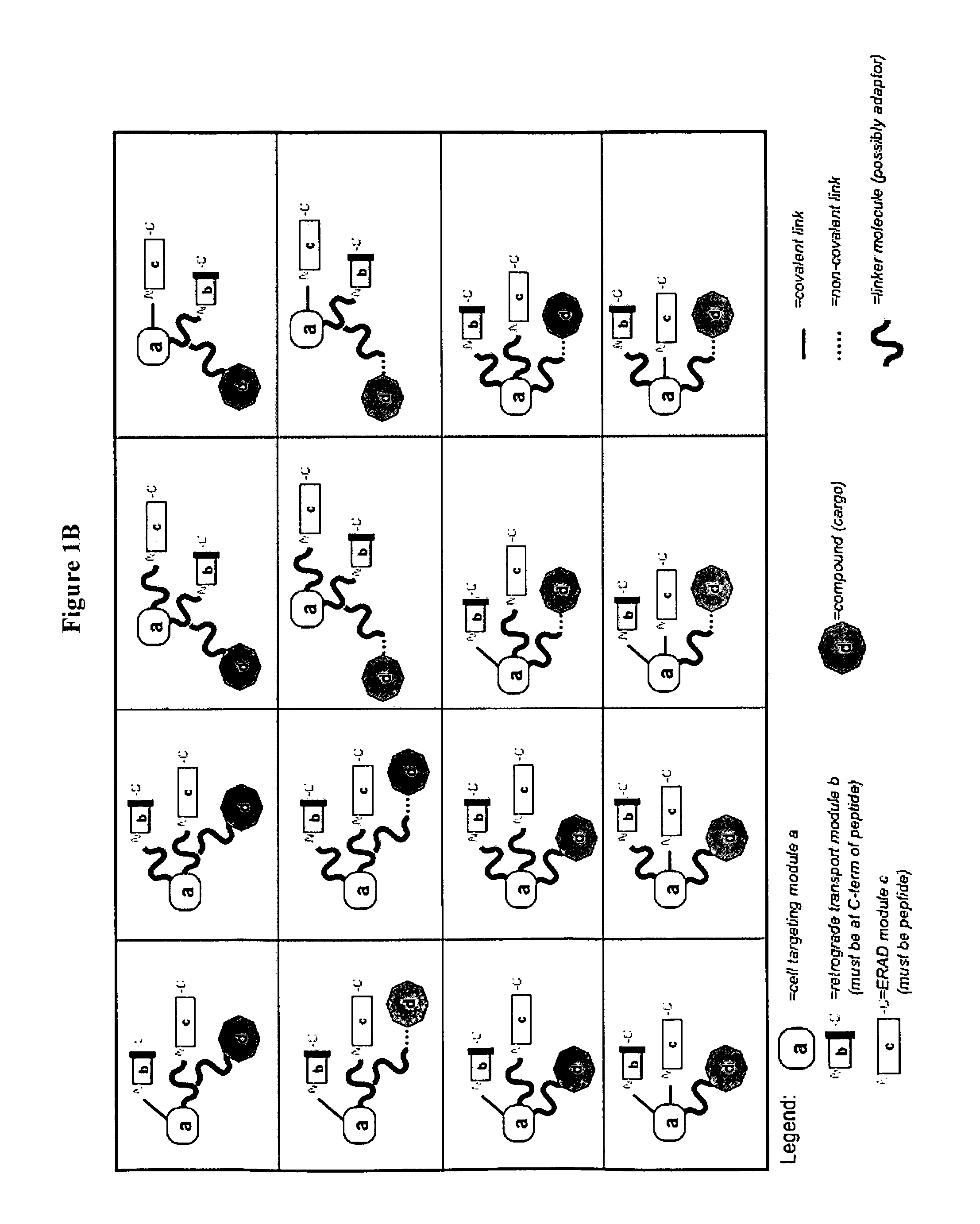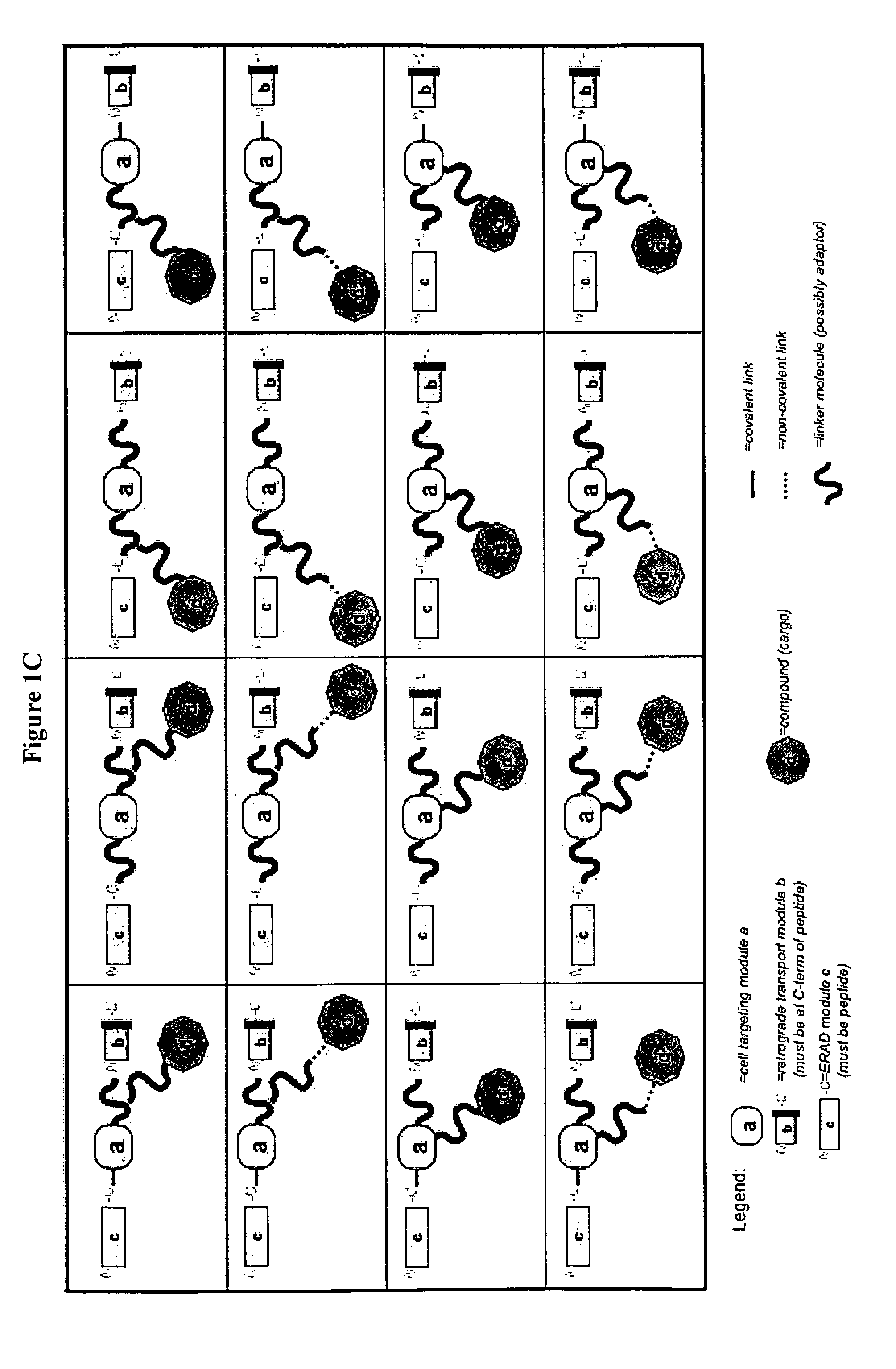Delivery System and Conjugates For Compound Delivery Via Naturally Occurring Intracellular Transport Routes
a delivery system and intracellular transport technology, applied in the direction of peptide sources, saccharide peptide ingredients, pharmaceutical non-active ingredients, etc., can solve the problems of limiting the application of large molecules for research, unable to reach the compartments within the cell where their sites of action may reside, and unable to efficiently cross the plasma membrane of animal cells by most large molecules, etc., to achieve wide range of application, low toxicity, and high efficiency
- Summary
- Abstract
- Description
- Claims
- Application Information
AI Technical Summary
Benefits of technology
Problems solved by technology
Method used
Image
Examples
examples
[0444]Abbreviations used herein include: kilogram (kg), milligram (mg), milliliter (mL), microliter (μL), molar (M), millimolar (mM), micromolar (μM), micromoles (μmol), nanomoles (nmol), hour (h), kiloDalton (kDa), degrees Celsius (° C.), minute (min), millimeter (mm), micron (μm), nanometer (nm), amino acid (aa), wild-type (wt), gravity (g), and intraperitoneal (i.p.).
Example (1)
Synthesis of DARE™ delivery system delivery modules and preparation of the modules-siRNA conjugate DARE™-R-CX (FIG. 2, DARE™ 2.01) and DARE™-R-AK-CX (DARE™ Delivery Vehicle Design 2.03)
[0445](i) Synthesis of the Linkage Molecules Containing Delivery Modules (b) and (c):
[0446]Two [“module (b)+module (c)”+linker] molecules: H2N—C(NPyS)(S-G)3(DprAoa)(S-G)3 NASSSRSGLDDINPTVLLKERSTEL-OH [“module (b)+module (c)” functionalities are provided by a human COX2 peptide comprising an amino acid sequence comprising SEQ ID NO: 177; CX1] and H2N—C(NPyS)(S-G)3(DprAoa)(S-G)3NASSSRSGLDDINPTVLLK AKDEL-OH [“module (b)+module ...
example 9
RNA Isolation
[0603]After euthanasia, tumors are removed and immediately frozen in liquid nitrogen. RNA is isolated from tumor tissue with the RNeasy kit (Qiagen) according to the manufacturer's manual and RNA quality is determined with an Agilent 2100 Bioanalyzer using the RNA 6000 Nano kit (Agilent) according to the manufacturer's instructions.
5′ RACE-PCR:
[0604]5′ RACE-PCR is performed on individual tumor samples as described above in Example (9) using VEGF specific 5′ and 3′ primers and nested primers.
RT-qPCR:
[0605]RT-qPCR is performed on individual tumor samples using an SDS7900 Thermocycler (Applied Biosystems) with gene specific validated VEGF TaqMan probes (Hs00900055 ml, Applied Biosystems) according to the manufacturer's recommendations. Gene expression is normalized to a pool of housekeeping genes (e.g. 18S rRNA, RPLPO, Hmbs, Ppib, and / or Pgk1) selected for gene expression analysis in PC3 tumors to normalize for natural expression variation in vivo as previously described [...
example
(20)
Synthesis of DARE™ 3.02 constructs (DARE™-T-AK-SGK), Sgk1-TfR-AKDEL-siRNA (see FIG. 11), carrying fLuc and GAPDH targeted siRNAs respectively
[0673](i) Synthesis of the Linkage Molecule Containing Modules (a), (b) and (c), viz. Sgk1-TfR-AKDEL
[0674]The [module (a) (SEQ ID NO: 121)+module (b) (SEQ ID NO: 161)+module (c) (SEQ ID NO: 199)+linker peptide (SEQ ID NO: 7)] of sequence MTVKTEAAKGTLTYSRMRGMVAILIAFMKQ-(S-G)3-Cys-(S-G)3-THRPPMWSPVWPA KDEL was synthesized by standard solid-phase Fmoc chemistry, deprotected in the standard fashion and purified twice by preparative reversed phase HPLC. The purity was estimated at 57-84% (due to shoulders on the back and front of the peak) by analytical reversed phase HPLC on a Vydac 218TP54 column using a gradient from 0.1% aqueous TFA to 0.1% TFA in 60% acetonitrile during 40 min, eluted at 1 mL / min. The mass measured by matrix assisted laser desorption ionization mass spectroscopy (MALDI-MS) in positive ion mode was 6346.81 Da for M+H+; the c...
PUM
| Property | Measurement | Unit |
|---|---|---|
| flow rate | aaaaa | aaaaa |
| pH | aaaaa | aaaaa |
| mass | aaaaa | aaaaa |
Abstract
Description
Claims
Application Information
 Login to View More
Login to View More - R&D
- Intellectual Property
- Life Sciences
- Materials
- Tech Scout
- Unparalleled Data Quality
- Higher Quality Content
- 60% Fewer Hallucinations
Browse by: Latest US Patents, China's latest patents, Technical Efficacy Thesaurus, Application Domain, Technology Topic, Popular Technical Reports.
© 2025 PatSnap. All rights reserved.Legal|Privacy policy|Modern Slavery Act Transparency Statement|Sitemap|About US| Contact US: help@patsnap.com



